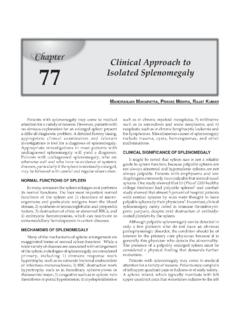Transcription of Lymphadenopathy and systemic lupus erythematosus - SciELO
1 CASE REPORT99 Bras J Rheumatol 2010;50(1):96-101 Received on 01/19/2009. Approved on 10/06/2009. We declare no conflict of Department of the University Hospital of the Medical School of Universidade Federal de Mato Grosso do Sul (FAMED UFMS)1. Rheumatology Residents of Hospital das Cl nicas of the Medical School of Universidade de S o Paulo (HC FMUSP)2. Physician of the Rheumatology Department of HC FMUSPC orrespondence to: Dr. Maur cio Levy-Neto. Disciplina de Reumatologia, FMUSP. Av. Dr. Arnaldo, 455, 3 andar, sala 3133, CEP 01246-903, Cerqueira C sar, S o Paulo, SP, Tel: 55 11 3061-7492, Fax: 55 11 3061-7490.
2 E-mail: and systemic lupus erythematosusNilton Salles Rosa Neto1, Karina Rossi Bonfiglioli1, Fernanda Manente Milanez1, Patr cia Andrade de Mac do1, Maur cio Levy-Neto2 ABSTRACTL ymphadenopathy is a benign finding in systemic lupus erythematosus (SLE), commonly seen in young patients with cutaneous involvement and constitutional symptoms, with good response to corticosteroids. Reactive follicular hyperpla-sia is the most frequent finding in biopsies. We report the case of a patient with recurrent episodes of Lymphadenopathy associated with hepatosplenomegaly, fever, and weight loss since the age of 13 years.
3 The patient also developed arthritis, hypertension, proteinuria, cardiomyopathy, and peripheral neuropathy. His condition was investigated extensively without diagnostic clarification; he was treated, empirically, for tuberculosis. The patient received a diagnosis of SLE only five years after the original presentation and received the specific treatment. Early diagnosis in those cases is difficult because laboratorial exams may not show the presence of auto-antibodies and low complement : systemic lupus erythematosus , fever of unknown origin, wasting syndrome, auto-antibodies, is characterized by changes in the number, characteristics, or size of the lymph nodes.
4 It results from reticuloendothelial proliferation secondary to inflammation, infection, or malignancies. In systemic lupus erythematosus (SLE) it represents a benign finding, with a mononucleosis-like behavior, and it can be seen in any phase of the commonly shows reactive follicular hyperplasia (RFH), with or without atypical cells, and it is considered a non-specific finding. Coagulative necrosis with hematoxylin bodies, typical findings in SLE, is rarely ,5We report the case of a patient with recurrent episodes of Lymphadenopathy treated initially as infectious in origin, who was later diagnosed with REPoRTThis is an 18 years old male patient from S o Paulo, SP.
5 In 2003, the patient developed recurrent episodes of lymphadenomegaly, hepatomegaly, fever in the evening, diaphoresis, and weight loss, lasting several months and with spontaneous 2004, the patient developed anasarca, which subsided, and hypertension, which persisted. In the following year the patient developed arthritis in the knees. At that time, rheumatoid factor and anti-nuclear factor (ANF) were negative and complement levels were biopsy of the lymph nodes showed RFH, and investigation for tuberculosis was negative. He had a PPD of 5 mm and normal chest X-ray, but the team responsible for his cared instituted treatment for tuberculosis (rifampin, isoniazid, and pyrazinamide).
6 With recurrence of the symptoms, ethambutol was added to the regimen for therapeutic failure. After a new recurrence in 2008 associated with polyarthritis and proximal muscular weakness, the patient was referred to the reference hospital due to refractory tuberculosis, where pleural and pericardial effusion, hepatosplenomegaly, and generalized lymphadenomegaly, along with a 20-kg weight loss, were ruling out infectious causes, a new lymph node biopsy showed RFH (Figure 1). This time the ANF was positive and the patient was referred to a test revealed anemia of chronic disease, normal muscle enzymes, proteinuria of g/24 hours without 100 Bras J Rheumatol 2010;50(1):96-101 Rosa Neto et , and elevated inflammatory acute phase reactants.
7 The ultrasound scan showed parenchymatous nephropathy, and the echocardiogram showed diffuse hypokinesis and ejection fraction 55% (in a previous exam it was higher than 70%). Electroneuromyography showed chronic peripheral neuropathy without evidence of myopathy. Neoplastic causes were ruled patient had positive ANF with a speckled pattern (titer higher than 1/320), and positive anti-Ro, anti-P, and IgG and IgM anticardiolipin antibodies. Kidney biopsy showed membranous patient received the diagnosis of SLE and treatment with prednisone, 60 mg/d, chloroquine diphosphate, 250 mg/d, and azathioprine, 100 mg/d, was instituted.
8 The patient is currently asymptomatic and on decreasing doses of clinical presentation and evolution of SLE shows a wide variety. The immunopathogenesis of SLE is associated with genetically determined loss of self-tolerance and cellular activation dependent of non-genetic factors, such as environmental, hormonal, and infectious. Activation of T lymphocytes by -interferon stimulates the sequence of progressive and persistent expansion of apoptosis-resistant polyclonal B lymphocytes, which produce auto-antibodies characteristics of the Lymphadenopathy (LL)
9 Has an estimated prevalence between 5 and 7%, at the onset of the disease, and 12 to 15%, at stage of the ,8 lupus Lymphadenopathy involves, mainly, the cervical and axillary regions, and the lymph nodes are soft, mobile, painful, and non-adherent to deep In case of significant Lymphadenopathy , lymph node biopsy is indicated to rule out infectious or lymphoproliferative Table 1 includes the most important differential diagnosis in those Lymphadenopathy can be classified as localized (involvement of up to two lymph node chains) or generalized (three or more).
10 Findings of malar erythema, photosensitivity, alopecia, oral ulcers, fever, weight loss, nocturnal sudoresis, and hepatosplenomegaly are expected. Kojima et demonstrated a higher incidence of LL in women, association with systemic symptoms and altered laboratorial exams, and RFH on histology. However, they identified atypical histological characteristics and classified them as: RFH with giant follicles: irregular follicles, increased in size, with hyperplastic germinal center, and cytolysis. Aspects similar to Castleman s disease (CD): plasmacytosis and interfollicular vascular proliferation; it might be mistaken for the mixed form of CD.
















